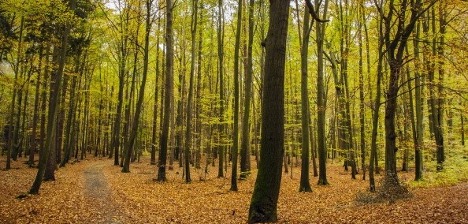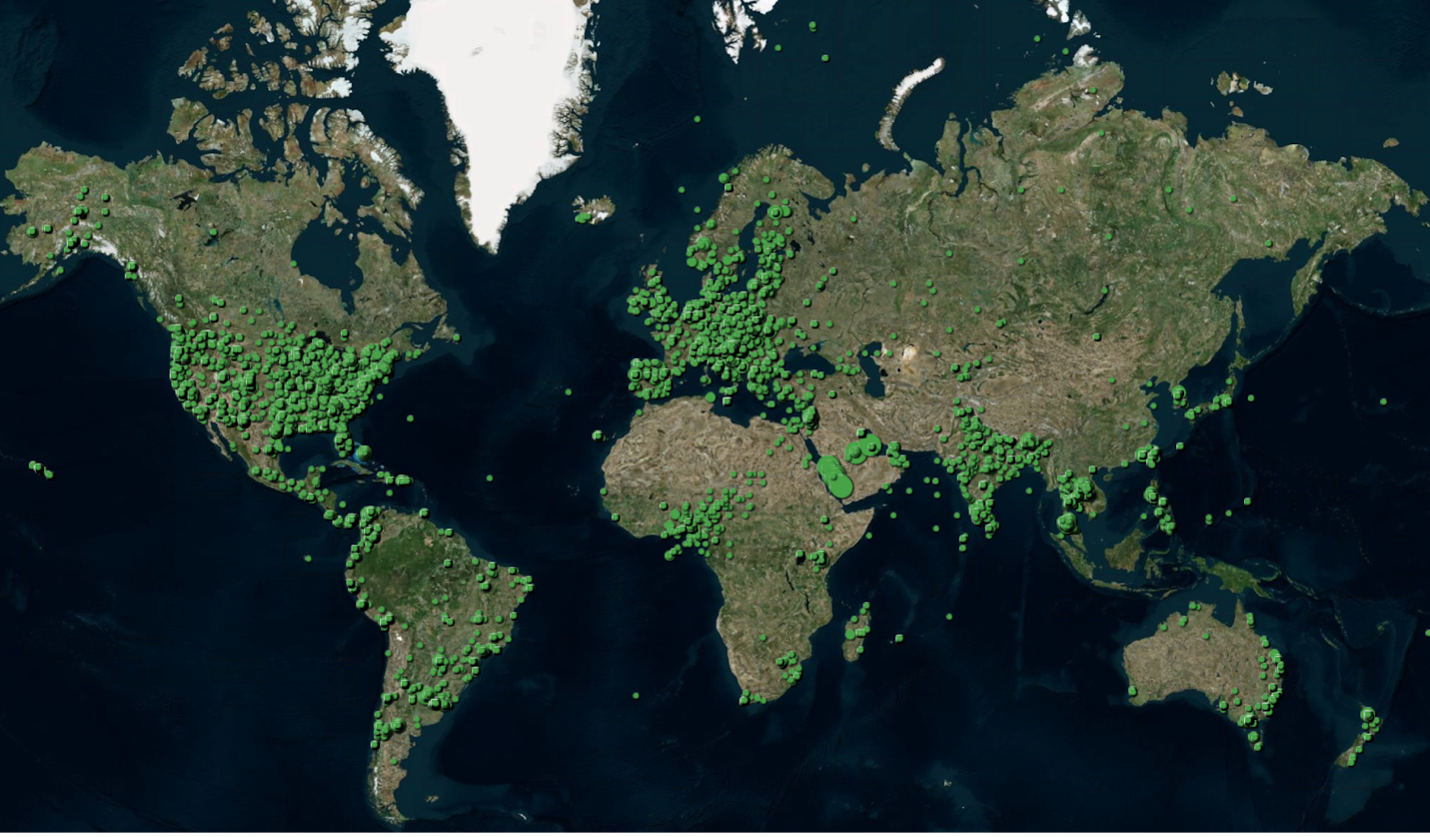News - GLOBE Observer
A Call for Daily Observations of Fall Color to Support Student Research Campaigns
GLOBE students across North America and Europe are working together to document seasonal change this September through December. The Trees Within LAC (Latin America and Caribbean region) Campaign is also collecting information about the tree species of the localities where students reside and their dynamics over time. We invite volunteers of all ages and in all countries to support their work by collecting regular Trees and Land Cover data with GLOBE Observer.

Have you ever seen the leaves changing from green to brown in the fall, then falling from the trees? If you have, you have witnessed the natural phenomena called green-down. Have you noticed if green-down occurs at the same time each fall season, or have you noticed that it tends to shift earlier or later in the season, depending on weather patterns? Or perhaps you have noticed green down happening later or the colors being duller compared to decades ago?
If you have noticed changes, you are witnessing a plant’s or tree’s response to seasonal changes, warming and an ever-changing climate or phenology. There are many factors involved when we talk about plants’ response to climate change, but how do we know these things are happening across the planet? According to the NASA Climate Science Website:
“Earth-orbiting satellites and new technologies have helped scientists see the big picture, collecting many different types of information about our planet and its climate all over the world. These data, collected over many years, reveal the signs and patterns of a changing climate.”
Climate change can be seen on a local to global scale, but how can you see these changes in your own backyard? One way is to observe the time of green-down (and green-up) of trees and vegetation around you. Satellites see a lot from space: they see the world’s forests in broad swaths. You see the individual trees in your backyard or neighborhood park. You can provide important information about when a single tree changes ahead of or behind others, while the satellite provides information about when most trees have changed. This combination of space-based data and ground-based data provides a much stronger picture of Earth’s changing phenology.
GLOBE students have been involved in collecting phenology data for decades following the green-up and green-down protocols. Through GLOBE Observer Trees and Land Cover, volunteers of all ages can provide supporting data.

Locations of GLOBE Green-Down observations in the GLOBE
database. These observations have been taken with the GLOBE
Program’s Green-Down Protocol.

Locations of GLOBE Tree Height observations in the GLOBE database. These observations are a combination of hand-held clinometers, as part of the GLOBE Biometry Protocol’s Tree Height measurements and GLOBE Observer Trees tool observations.
2024 GLOBE Phenology Campaigns

Between September and December 2024, the GLOBE Program will be
running an Intensive
Observation Period (IOP) to gather observations of green-down.
An IOP is a focused period of time where participants are encouraged
to collect large amounts of data and enter it in the GLOBE database.
This IOP is in conjunction with the GLOBE
North America Phenology Campaign and the European
Phenology Campaign, campaigns that focus on monitoring and
reporting plant phenology data to help validate the timing of the
plant growing season. The Trees
Within LAC Campaign is also regularly holding webinars related to collecting
information about tree species and their dynamics over time. Even
though these are campaigns based in North America (United States and
Canada), Europe, and the Latin America and Caribbean region, we are
seeking the following from every GLOBE country:
- Regular (daily if possible) photos of a tree using GLOBE Observer Trees to capture its change from green to leaves fully off or, in the Southern Hemisphere, leaf buds to full leaf. Regular (daily if possible) observations of tree height for the same tree to collect repeat observations. Scientists often collect repeat observations of what they are measuring, since repeat data can be averaged together to reduce the impact of error on the measurement, making the data more reliable. Not only is repeat data extremely valuable, you can earn a Trees streak in the GLOBE Observer app!
- Regular observations of land cover for the same location to capture the broader change around the tree. You can also earn a Land Cover streak with daily observations.
Since climate change is global, we need observations from everywhere. Your observations can help students, educators, and scientists around the world.
Need more support? These videos provide guidance on choosing and measuring a tree for the campaign.
- North America Phenology Campaign Mini Tutorial: Selecting a Site and a Tree
- How to Take a GLOBE Observer Tree Height Observation Video
- How to Take a GLOBE Observer Land Cover Observation Video
Why are repeat observations important and what can they tell us?
Markus Eugster is a GLOBE educator from Uzwil, Switzerland. He is a secondary school teacher who focuses on science and mathematics, as well as teaching courses in history, geography, computer science and even electronics and art! Markus integrates his passion for science and the natural world in each subject he teaches.
Markus works with his students to document the changing seasons through phenological observations, especially green-up and green-down, and he imparts the importance of taking repeated observations.
“One-time observations document only instantaneous conditions. Only repeated observations reveal changes and developments,” Markus stated. He continues by saying that, “as green-down and green-up are steadily running processes, you can conceive and understand them only by repeated observations. For many students it's quite a challenge in the beginning to document such slowly running processes reliably over a long period of time.”
So, how do the students know that their observations are important and can tell an environmental story? Markus states, “even if repeated observations bring the same result several times, they are more valuable than single observations as they reveal a standstill or the end of a development which isn't evident from a single observation. Even more exciting is to repeat repeated observations next year and the following, and so on… as only this procedure allows you to understand how the process as a whole (e.g. green-down and green-up) is changing over time.”

Markus Eugster (inset) and his students from Switzerland, doing GLOBE Phenology observations and matching leaf color.
Do you want to learn more about green-down and why leaves change their color? If so, our friends at the GLOBE European Phenology Campaign have created some great materials, including this three-page informative document, “Why do the leaves change color?” with associated activities. You can also join us for a conversation about this blog in our September GLOBE Observer Connect session on 19 September 2024 at 12 pm ET (16:00 UTC) - learn more and find the registration link on the event page.

For those that are registered as an educator with the GLOBE Program, there is a formal green-down protocol, which allows for a deeper-dive into observing and documenting the green-down process. The green-down protocol can be found in the GLOBE Green-Up/Green-Down Protocols. If you are an educator, who is new to the GLOBE Program and would like to join, this is a great opportunity to do so, and is a great time to learn all about the importance of green-down. You can register as a GLOBE Educator at the GLOBE “Create an Account” page by selecting the “Teacher/Formal Educator” option, and go from there. It is easy to register, and GLOBE will guide you through the process.
About the Authors:
Brian Campbell (NASA Wallops/GST, Inc.) is a NASA Senior Earth Science Specialist and Subject Matter Expert at the NASA Goddard Space Flight Center’s Wallops Flight Facility in Wallops Island, Virginia, USA. Brian is also the Trees Around the GLOBE Student Research Campaign lead and the Trees science lead for The GLOBE Program’s GLOBE Observer citizen science program and serves as the NASA Wallops Flight Facility Earth Science Liaison. Brian, in his 24th year at NASA, works with local to international students, educators, citizen scientists, and researchers in over 120 countries.
Markus Eugster (GLOBE Switzerland/Sekundarschule Uzwil) lives in Uzwil, Switzerland, a little town about halfway between Zurich and Lake Constance. He is a secondary school teacher that focuses on science and mathematics subjects, as well as teaching courses in history, geography, computer science and even electronics and art! Markus integrates his passion for citizen science and the natural world in each subject, despite such a wide array of topics. With his students, Markus integrates GLOBE protocols into his curriculum with classroom projects that are observation-centered.
Comments
View more GLOBE Observer news here.








